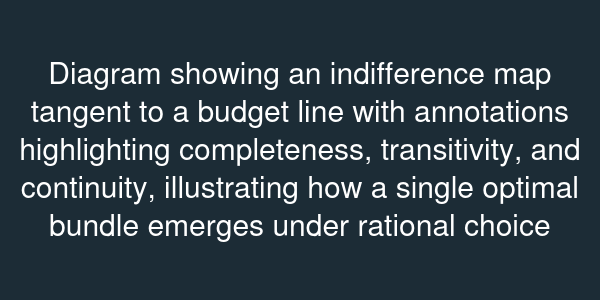Rational Choice Theory
Essential Questions
- Which preference axioms guarantee a well-behaved utility function?
- How do you move from verbal preferences to a constrained optimization problem?
- Where do real decision makers break these assumptions?
Overview
Imagine you are designing a recommendation engine for a personal finance app. You need to predict how a user chooses between bundles of consumption in period one and savings for period two. Rational choice theory gives you the blueprint: assume preferences are complete, transitive, and continuous, then represent them with a utility function. Yet when you beta test, people sometimes prefer A to B, B to C, and C back to A. The algorithm sputters.
This lesson walks you through the classical math and the cracks that behavioral data expose. You will practice turning qualitative statements like "you prefer security to risk" into a maximization problem, then probe how actual people violate the tidy assumptions.
Building Utility from Axioms
Classical microeconomics posits that for any two bundles and , you can say or (completeness), and if and , then (transitivity). Add continuity so that small changes do not flip preferences abruptly. Under these conditions, the Debreu representation theorem ensures there exists a continuous utility function such that if and only if .
The consumer problem becomes subject to , where is the price vector and the wealth level. Solving yields demand functions obtained by taking the gradient of the Lagrangian , setting , and applying the budget constraint. This calculus-based optimization is the backbone of supply and demand diagrams.

Violations in the Wild
Behavioral experiments reveal systematic breaches. In preference reversal tasks, participants assign higher certainty equivalents to gamble A but choose gamble B when asked directly. The axiom of procedure invariance collapses. Cyclical preferences appear in food choices and voting, documented by psychologist Amos Tversky. If a diner ranks salmon over steak and steak over pasta, classical theory forbids preferring pasta over salmon. Yet menu context can make that cycle real.
One way to capture such inconsistencies is to introduce a utility function with context-dependent terms, such as where represents the choice set. The inclusion of "decoy" options changes and therefore the effective ranking. Another approach is to relax transitivity to allow for "semi-orders" where tiny differences are treated as indifference regions; this better describes coffee drinkers who cannot distinguish between nearly identical lattes.
Why Rational Choice Still Matters
Even when data break the axioms, rational models offer a baseline. Behavioral economists measure the size of deviations relative to a rational benchmark. For instance, when evaluating a savings nudging policy, you compare actual contribution rates to the optimum predicted by with exponential discounting. The gap quantifies behavioral frictions.
As you move forward, you will reuse the rational toolbox—Lagrangians, first-order conditions, comparative statics—but you will enrich it with parameters capturing loss sensitivity, fairness concerns, and reference points. Mastery of rational choice gives you the language to describe when the invisible hand works flawlessly and when the invisible biases push outcomes off script.